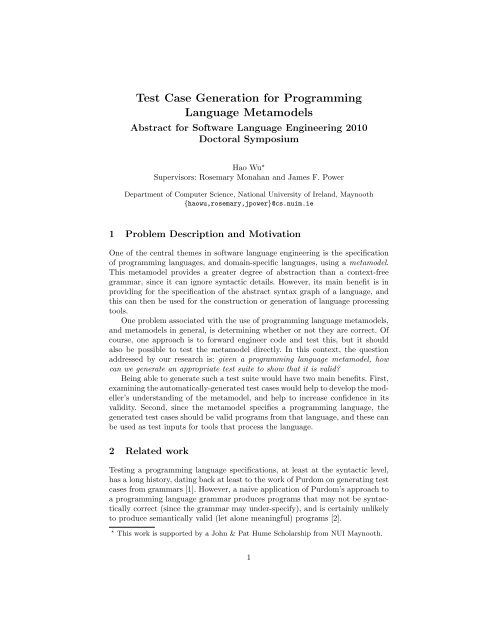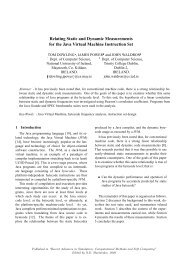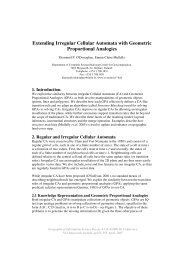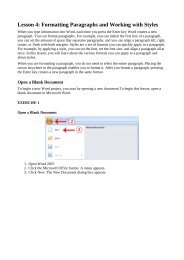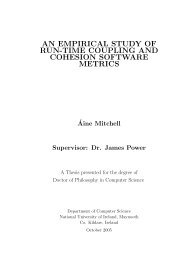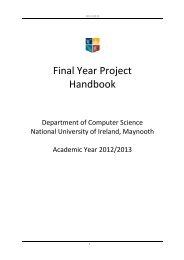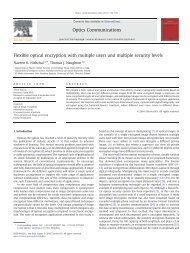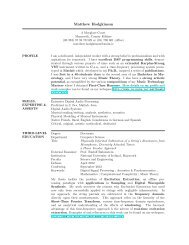Test Case Generation for Programming Language Metamodels
Test Case Generation for Programming Language Metamodels
Test Case Generation for Programming Language Metamodels
Create successful ePaper yourself
Turn your PDF publications into a flip-book with our unique Google optimized e-Paper software.
<strong>Test</strong> <strong>Case</strong> <strong>Generation</strong> <strong>for</strong> <strong>Programming</strong><br />
<strong>Language</strong> <strong>Metamodels</strong><br />
Abstract <strong>for</strong> Software <strong>Language</strong> Engineering 2010<br />
Doctoral Symposium<br />
Hao Wu ⋆<br />
Supervisors: Rosemary Monahan and James F. Power<br />
Department of Computer Science, National University of Ireland, Maynooth<br />
{haowu,rosemary,jpower}@cs.nuim.ie<br />
1 Problem Description and Motivation<br />
One of the central themes in software language engineering is the specification<br />
of programming languages, and domain-specific languages, using a metamodel.<br />
This metamodel provides a greater degree of abstraction than a context-free<br />
grammar, since it can ignore syntactic details. However, its main benefit is in<br />
providing <strong>for</strong> the specification of the abstract syntax graph of a language, and<br />
this can then be used <strong>for</strong> the construction or generation of language processing<br />
tools.<br />
One problem associated with the use of programming language metamodels,<br />
and metamodels in general, is determining whether or not they are correct. Of<br />
course, one approach is to <strong>for</strong>ward engineer code and test this, but it should<br />
also be possible to test the metamodel directly. In this context, the question<br />
addressed by our research is: given a programming language metamodel, how<br />
can we generate an appropriate test suite to show that it is valid<br />
Being able to generate such a test suite would have two main benefits. First,<br />
examining the automatically-generated test cases would help to develop the modeller’s<br />
understanding of the metamodel, and help to increase confidence in its<br />
validity. Second, since the metamodel specifies a programming language, the<br />
generated test cases should be valid programs from that language, and these can<br />
be used as test inputs <strong>for</strong> tools that process the language.<br />
2 Related work<br />
<strong>Test</strong>ing a programming language specifications, at least at the syntactic level,<br />
has a long history, dating back at least to the work of Purdom on generating test<br />
cases from grammars [1]. However, a naive application of Purdom’s approach to<br />
a programming language grammar produces programs that may not be syntactically<br />
correct (since the grammar may under-specify), and is certainly unlikely<br />
to produce semantically valid (let alone meaningful) programs [2].<br />
⋆ This work is supported by a John & Pat Hume Scholarship from NUI Maynooth.<br />
1
Incorporating at least a language’s static semantics into test suite generation<br />
must go beyond simple context-free grammars. One possible approach is to use<br />
attribute grammars, and to seek to exploit the attribute equations to constrain<br />
or even direct the generation of test cases [3, 4]. Despite this research, it is still<br />
not a trivial task to directly extend this work to a metamodelling environment<br />
that uses, <strong>for</strong> example, OCL-like constraints <strong>for</strong> describing the static semantics.<br />
It is possible to borrow some ideas from software modelling, and there is a<br />
great deal of existing research dealing with model-based testing strategies [5,<br />
6]. However, much of this work focuses on the behavioural elements of software<br />
models (such as state machines), rather than the structural aspects which might<br />
be more relevant to metamodelling.<br />
In the context of testing structural models, two tools strike us as being particularly<br />
noteworthy:<br />
– USE (a UML-Based Specification Environment) which allows the user to<br />
specify a UML (Unified Modeling <strong>Language</strong>) class diagram with OCL constraints<br />
[7]. From these we can manually generate corresponding object diagrams,<br />
and the USE environment will check that these are valid instances,<br />
satisfying the relevant class invariants.<br />
– Alloy which has its own logical specification language, corresponding roughly<br />
to the elements found in a class diagram, and automatically generates object<br />
diagrams that correspond to this specification [8]. One of the useful aspects<br />
of the Alloy tool is that it is designed to work with a number of different<br />
SAT solvers in order to test constraints and generate counter-examples.<br />
As part of an earlier project, we have previously exploited the close relationship<br />
between the Alloy notation and UML class diagrams to generate instances<br />
of a metamodel <strong>for</strong> software metrics [9]. One of the drawbacks of this<br />
earlier approach is that it did not control the strategy used to generate instances.<br />
Faced with the impossibility of manually validating several hundred thousand<br />
instances, we exploited test-suite reduction techniques to narrow the set of test<br />
cases.<br />
3 Proposed Solution<br />
It is clearly inefficient to generate test cases that are not used, and an ideal<br />
solution would be to generate an appropriate set of test cases in the first place. Of<br />
course, this immediately raises two questions: what do we mean by an appropriate<br />
set of test cases, and how do we generate these test cases<br />
One way of measuring the adequacy of a set of test cases <strong>for</strong> a piece of<br />
software is to use coverage criteria. Typically, a test suite can be judged in terms<br />
of the percentage of statements, decisions, branches etc. in the source code that<br />
are executed when the software is run. It seems natural there<strong>for</strong>e to attempt to<br />
seek to assemble a test suite <strong>for</strong> a metamodel along similar lines, i.e. to <strong>for</strong>m a<br />
set of models that cover the features of the metamodel. In terms of programming<br />
language metamodels, this would involve creating a set of programs that exercise<br />
the features of the language.<br />
2
Since most metamodels, including programming language metamodels, are<br />
described using UML, it is possible to use UML techniques to compute their<br />
coverage. Many coverage criteria <strong>for</strong> the various UML diagrams have been proposed<br />
[10–13]. However, we restrict our attention to UML structural diagrams,<br />
since metamodels are often presented in the <strong>for</strong>m of UML class diagrams.<br />
Our recent work has focused on coverage criteria <strong>for</strong> UML class diagrams<br />
initially proposed by Andrews et al. [14], specifically:<br />
– Generalisation coverage which describes how to measure inheritance relationships.<br />
– Association-end multiplicity coverage which measures association relationships<br />
defined between classes.<br />
– Class attribute coverage which measures the set of representative attribute<br />
value combinations in each instance of class.<br />
It is unlikely that these alone will provide sufficient granularity to determine<br />
the adequacy of a test suite, and previous work has already determined that<br />
there is a poor correlation between coverage of syntactic and semantic features<br />
[15]. However, our immediate work has centred on constructing an extensible,<br />
modular system that can at least measure these levels of coverage, and which<br />
can be used as a basis <strong>for</strong> further studies.<br />
4 Research Method<br />
Our research can be broken down into three phases:<br />
Phase I: calculating coverage measures <strong>for</strong> programming language metamodels,<br />
Phase II: generating valid models that satisfy coverage criteria,<br />
Phase III: generating models satisfying criteria not based on coverage.<br />
In our work to date we have constructed a tool-chain which, when given a<br />
UML class diagram and a set of UML object diagrams, will calculate the three<br />
coverage measures described above [16]. The tool chain uses the USE tool as<br />
a parser and validator <strong>for</strong> the class and object diagrams, and uses the Eclipse<br />
Modeling Framework (EMF) to represent these as instances of the UML metamodel.<br />
To represent the output we have built a coverage metamodel in EMF<br />
which is essentially an extension of an existing metrics metamodel [17]. Finally,<br />
we have written a trans<strong>for</strong>mation to calculate the coverage measures using ATL<br />
(ATLAS Trans<strong>for</strong>mation <strong>Language</strong>).<br />
In order to complete the first phase we intend to extend the coverage measures<br />
<strong>for</strong> class diagrams to deal with the associated OCL constraints. We intend to<br />
use (OCL) decision coverage as our initial measure, and to extend our tool chain<br />
to implement this coverage.<br />
In the next phase, we hope to generate valid models that satisfy coverage<br />
criteria <strong>for</strong> at least one programming language metamodel. We are currently<br />
studying Alloy’s approach as a model of exploiting third-party SAT solvers to<br />
control model generation.<br />
At the final phase of our research we hope to expand this approach to other<br />
language-based criteria. To do this, we intend to use OCL-based queries across<br />
3
the metamodel to specify the kind of model to be generated. Ideally, this would<br />
allow a user to specify the kind of programs that would be generated in the test<br />
suite <strong>for</strong> a given language metamodel.<br />
References<br />
1. Purdom, P.: A sentence generator <strong>for</strong> testing parsers. BIT 12(3) (1972) 366–375<br />
2. Malloy, B.A., Power, J.F.: An interpretation of Purdom’s algorithm <strong>for</strong> automatic<br />
generation of test cases. In: 1st Annual International Conference on Computer and<br />
In<strong>for</strong>mation Science, Orlando, Florida, USA (October 3-5 2001)<br />
3. Lämmel, R.: Grammar testing. In: Fundamental Approaches to Software Engineering.<br />
Volume 2029 of Lecture Notes in Computer Science., Springer Verlag (2001)<br />
201–216<br />
4. Lämmel, R., Schulte, W.: Controllable combinatorial coverage in grammar-based<br />
testing. In: 18th IFIP TC6/WG6.1 International Conference on <strong>Test</strong>ing of Communicating<br />
Systems, New York, NY (May 2006) 19–38<br />
5. Pilskalnsa, O., Andrews, A., Knight, A., Ghosh, S., France, R.: <strong>Test</strong>ing UML<br />
designs. In<strong>for</strong>mation and Software Technology 49(8) (August 2007) 892–912<br />
6. Utting, M., Legeard, B., eds.: Practical Model-Based <strong>Test</strong>ing. Elsevier (2007)<br />
7. Gogolla, M., Büttner, F., Richters, M.: USE: A UML-based specification environment<br />
<strong>for</strong> validating UML and OCL. Sci. Comp. Prog. 69(1-3) (2007) 27–34<br />
8. Jackson, D.: Software Abstractions. MIT Press (2006)<br />
9. McQuillan, J.A., Power, J.F.: A metamodel <strong>for</strong> the measurement of object-oriented<br />
systems: An analysis using Alloy. In: IEEE International Conference on Software<br />
<strong>Test</strong>ing Verification and Validation, Lillehammer, Norway (April 9-11 2008) 288–<br />
297<br />
10. McQuillan, J., Power, J.: A survey of UML-based coverage criteria <strong>for</strong> software<br />
testing. Technical Report NUIM-CS-TR-2005-08, NUI Maynooth (2005)<br />
11. Dinh-Trong, T.T., Ghosh, S., France, R.B.: A systematic approach to generate<br />
inputs to test UML design models. In: 17th International Symposium on Software<br />
Reliability Engineering, Raleigh, NC (2006) 95–104<br />
12. Mahdian, A., Andrews, A.A., Pilskalns, O.: Regression testing with UML software<br />
designs: a survey. J. of Software Maintenance and Evolution: Research and Practice<br />
21(4) (July/August 2009) 253–286<br />
13. Briand, L., Labiche, Y., Lin, Q.: Improving the coverage criteria of UML state<br />
machines using data flow analysis. Soft. <strong>Test</strong>. Verif. & Reliability 20 (2010)<br />
14. Andrews, A., France, R., Ghosh, S., Craig, G.: <strong>Test</strong> adequacy criteria <strong>for</strong> UML<br />
design models. Soft. <strong>Test</strong>. Verif. & Reliability 13(2) (April/June 2003) 95–127<br />
15. Hennessy, M., Power, J.F.: Analysing the effectiveness of rule-coverage as a reduction<br />
criterion <strong>for</strong> test suites of grammar-based software. Empirical Software<br />
Engineering 13(4) (August 2008) 343–368<br />
16. Wu, H., Monahan, R., Power, J.F.: Using ATL in a tool-chain to calculate coverage<br />
data <strong>for</strong> UML class diagrams. In: 2nd International Workshop on Model<br />
Trans<strong>for</strong>mation with ATL, Malaga, Spain (June 2010)<br />
17. Vépa, E.: ATL trans<strong>for</strong>mation example: UML2 to Measure. Available on-line<br />
as http://www.eclipse.org/m2m/atl/atlTrans<strong>for</strong>mations/#UML22Measure (August<br />
30 2007)<br />
4


